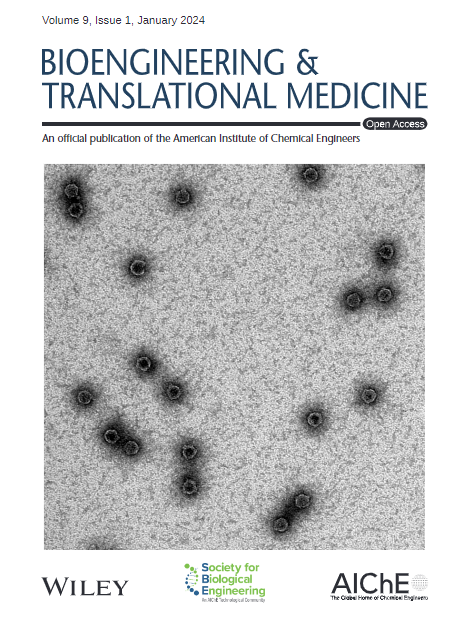工程内皮细胞靶向和负载二氢丹参酮的细菌细胞外囊泡用于动脉粥样硬化治疗
IF 5.7
2区 医学
Q1 ENGINEERING, BIOMEDICAL
引用次数: 0
摘要
动脉粥样硬化(AS)是一种复杂的心血管疾病,以内皮功能障碍、血脂异常和免疫炎症反应为特征,可导致动脉斑块形成和潜在的致命并发症,如心肌梗死和中风。传统的治疗方法,如他汀类药物,由于其副作用和有限的疗效,经常带来挑战。在这项研究中,我们探索了一种新的治疗方法,利用工程内皮细胞(ECs)靶向益生菌细胞外囊泡,这些囊泡装载了二氢丹参酮I (DHT) (EC‐BEVsDHT),一种来自丹参(丹参)的生物活性化合物。通过透射电镜和纳米颗粒跟踪分析对EC - BEVsDHT进行了表征,EC - BEVsDHT具有典型的球形形貌和粒径分布。高效液相色谱联用串联质谱法证实了EC - BEVsDHT和EC - BEVsDHT中EC -靶向肽VSSSTPR的表达。我们进一步研究了EC - BEVsDHT对人脐静脉内皮细胞(HUVECs)和载脂蛋白E -缺陷(ApoE−/−)C57BL/6J小鼠的抗动脉粥样硬化作用及其分子机制。我们发现EC‐BEVsDHT在体外减轻氧化低密度脂蛋白诱导的HUVECs损伤,并在体内降低ApoE−/−小鼠的AS。我们的研究结果表明,EC - BEVsDHT有望成为一种安全有效的治疗as的策略,与传统治疗方法相比具有潜在的优势。本文章由计算机程序翻译,如有差异,请以英文原文为准。
Engineered endothelial cells targeting and dihydrotanshinone I loaded bacterial extracellular vesicles for atherosclerosis therapy
Atherosclerosis (AS) is a complex cardiovascular disease characterized by endothelial dysfunction, dyslipidemia, and immune‐inflammatory responses, leading to arterial plaque formation and potentially fatal complications such as myocardial infarction and stroke. Traditional treatments, such as statins, often pose challenges due to their side effects and limited efficacy. In this study, we explore a novel therapeutic approach utilizing engineered endothelial cells (ECs) targeting probiotic extracellular vesicles loaded with dihydrotanshinone I (DHT) (EC‐BEVsDHT ), a bioactive compound derived from Danshen (Salvia miltiorrhiza Bunge). With the characterization of EC‐BEVsDHT by transmission electron microscope and nanoparticle tracking analysis, EC‐BEVsDHT exhibited typical spherical morphology and particle size distribution. High‐performance liquid chromatography coupled with tandem mass spectrometric confirmed the expression of the ECs‐targeting peptide VSSSTPR in EC‐BEVsDHT and EC‐BEVsDHT . We further investigated the anti‐atherosclerotic effects and molecular mechanisms of EC‐BEVsDHT on human umbilical vein endothelial cells (HUVECs) and Apolipoprotein E‐deficient (ApoE−/− ) C57BL/6J mice. We found that EC‐BEVsDHT attenuated oxidized low‐density lipoprotein induced HUVECs injury in vitro and decreased AS in ApoE−/− mice in vivo. Our findings suggest that EC‐BEVsDHT hold promise as a safe and effective therapeutic strategy for AS, offering potential advantages over traditional treatments.
求助全文
通过发布文献求助,成功后即可免费获取论文全文。
去求助
来源期刊

Bioengineering & Translational Medicine
Pharmacology, Toxicology and Pharmaceutics-Pharmaceutical Science
CiteScore
8.40
自引率
4.10%
发文量
150
审稿时长
12 weeks
期刊介绍:
Bioengineering & Translational Medicine, an official, peer-reviewed online open-access journal of the American Institute of Chemical Engineers (AIChE) and the Society for Biological Engineering (SBE), focuses on how chemical and biological engineering approaches drive innovative technologies and solutions that impact clinical practice and commercial healthcare products.
 求助内容:
求助内容: 应助结果提醒方式:
应助结果提醒方式:


